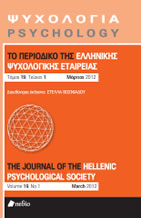Θετικές παρεμβάσεις στη Γνωσιακή-Συμπεριφορική Ψυχοθεραπεία

Περίληψη
Η Γνωσιακή-Συμπεριφορική Ψυχοθεραπεία αποτελεί μια εμπειρικά τεκμηριωμένη θεραπευτική προσέγγιση. Αν και αποτελεί τη θεραπεία επιλογής των αγχωδών και συναισθηματικών διαταραχών, ένα ποσοστό ασθενών που λαμβάνουν Γνωσιακή-Συμπεριφορική Ψυχοθεραπεία παρουσιάζουν συμπτώματα ακόμη και μετά τη λήξη της θεραπείας ή υποτροπές σε μακρόχρονες αξιολογήσεις. Κατά διαστήματα διάφορες τεχνικές έχουν προταθεί με στόχο τον εμπλουτισμό της συγκεκριμένης προσέγγισης και τη βελτίωση της αποτελεσματικότητάς της. Από τον ευρύτερο χώρο της Θετικής Ψυχολογίας, τρία θεραπευτικά προγράμματα, η Θεραπεία Ευζωίας, η Θεραπεία Χτισίματος Ελπίδας και η Θεραπεία Ποιότητας Ζωής, έχουν ενσωματωθεί σε ψυχοθεραπείες Γνωσιακού-Συμπεριφορικού τύπου με στόχο τη μεγιστοποίηση της αποτελεσματικότητάς τους και την πρόληψη υποτροπής. Σε αυτό το άρθρο παρουσιάζονται το θεωρητικό υπόβαθρο, η δομή και οι τεχνικές των θεραπευτικών αυτών προγραμμάτων. Αναφέρονται τα πρώτα ερευνητικά ευρήματα αναφορικά με την αποτελεσματικότητά τους σε θεραπεία ασθενών με άγχος και κατάθλιψη. Τέλος, γίνεται μια κριτική αποτίμηση της συμβολής τους στην αποτελεσματικότητα της Γνωσιακής- Συμπεριφορικής Ψυχοθεραπείας.
Λεπτομέρειες άρθρου
- Πώς να δημιουργήσετε Αναφορές
-
Μυτσκίδου Π., & Ιωάννης Β. (2020). Θετικές παρεμβάσεις στη Γνωσιακή-Συμπεριφορική Ψυχοθεραπεία. Ψυχολογία: το περιοδικό της Ελληνικής Ψυχολογικής Εταιρείας, 19(3), 297–312. https://doi.org/10.12681/psy_hps.23624
- Τεύχος
- Τόμ. 19 Αρ. 3 (2012)
- Ενότητα
- ΘΕΩΡΗΤΙΚΕΣ ΑΝΑΣΚΟΠΗΣΕΙΣ

Αυτή η εργασία είναι αδειοδοτημένη υπό το Creative Commons Attribution-ShareAlike 4.0 International License.
Το περιοδικό ΨΥΧΟΛΟΓΙΑ έχει υιοθετήσει μία πολιτική Platinum open-access. Τα έξοδα υποβολής, επεξεργασίας ή δημοσίευσης των εργασιών καλύπτονται από την Ελληνική Ψυχολογική Εταιρεία. Τα πνευματικά δικαιώματα των δημοσιευμένων εργασιών προστατεύονται από την άδεια 'Creative Commons Attribution-ShareAlike 4.0 International'. Οι Συγγραφείς διατηρούν τα Πνευματικά Δικαιώματα και χορηγούν στο περιοδικό το δικαίωμα της πρώτης δημοσίευσης. Η άδεια αυτή επιτρέπει σε τρίτους, να χρησιμοποιούν την εργασία σε οποιαδήποτε μορφή, με την προϋπόθεση της διατήρησης των διατυπώσεων που προβλέπονται στην άδεια σχετικά με την αναφορά στον αρχικό δημιουργό και την αρχική δημοσίευση στο περιοδικό ΨΥΧΟΛΟΓΙΑ. Επιπλέον, κάθε διανομή της εργασίας οφείλει να γίνεται με τους ίδιους όρους διανομής, δηλαδή με την ίδια άδεια Creative Commons.


